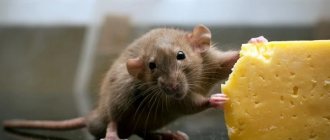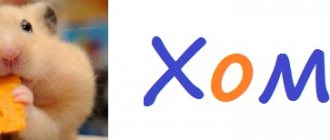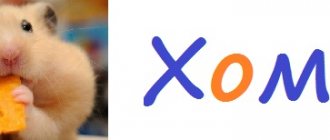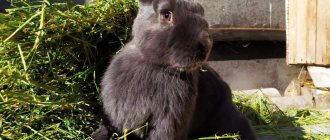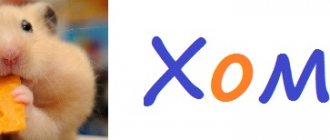Hamsters have become one of the popular caged animals. These little creatures come in many varieties, but some of the most famous are the Djungarian and Syrian hamsters. To keep a furry pet you only need a cage, a bowl and a drinking bowl. But careful care is also needed, feeding hamsters is an important part of caring for them so that they have good health and live a long life within their limits.
Hamster diet
The Syrian hamster is fed 2 times a day, morning and evening. Typically, Syrian hamsters will eat a tablespoon of their diet, but it all depends on the size and activity of the hamster. You can also periodically give pieces of fruit and other treats to your hamsters. At the same time, it is very important to monitor how much food the hamster can take in. If there is more food than he can eat, then the pet will make deposits for his food. It is worth making sure that the food does not start to rot; if this happens, then you need to remove these supplies in a timely manner.
Djungarian hamsters feed once a day. The feeding time of the hamster should be set in the morning or evening, and be sure to feed at the same specific time. Despite their small appearance, Djungarian hamsters are supposed to be given one tablespoon of food or cereal mixture.
What does a rodent eat in nature?
In the wild, the animal’s diet depends on its habitat. These are mainly grain crops, so rodents live, mainly in fields. In drier areas there is more dry food, in wetter areas there is more lush grass, leaves and other greenery. Rodents often raid places where grain, vegetables and other products are stored in rural houses and dachas. Rodents replenish their protein reserves by eating beetles, spiders, worms and caterpillars. They do not disdain the meat of another wounded small animal.
What can hamsters eat and what can’t hamsters eat?
It is important to have an idea of what you can feed hamsters, what fruits, vegetables or other types of foods can be given, and which are strictly prohibited or undesirable for your furry pet. Many owners give cabbage to their rodent, but only a few know that cabbage is harmful to the hamster’s digestion.
In addition to cereal mixtures and special foods, it is advisable to treat your pet with cereals, fruits, nuts, berries and dried fruits. Hamsters' food must contain a range of nutrients and vitamins. They provide essential vitamins and other beneficial substances.
What to feed hamsters:
- Carrots, broccoli, banana, cherries, currants (black/red), gooseberries, leeks, parsley, dill. These food sets contain vitamin A, which promotes the growth of new cells and has a positive effect on bones, fur and vision.
- Sunflower seeds, oatmeal, oats, peas, buckwheat, wheat, cashews, walnuts. Vitamin B affects the efficiency of digestion and has a good effect on the nervous system.
- Banana, apple, cherry, gooseberry, currant, blueberry, rose hip, radish, parsley, dill, dandelion leaves. These products contain vitamin C, which strengthens the immune system, promotes bone growth and cell repair.
- Sunflower seeds, cashews, wheat, barley, wheat and oatmeal, oats, walnuts, dill, dandelion leaves. These substances contain vitamin E. It is necessary for good blood circulation and muscle function.
List of prohibited products
What is strictly forbidden to feed a hamster:
- spicy, salty, smoked and canned foods;
- any spices;
- citrus and exotic fruits (lemons, oranges, tangerines, grapefruits, avocados, etc.);
- onion garlic;
- cabbage;
- potato;
- watermelon;
- mushrooms;
- sweets.
The list of prohibited herbs includes cereal leaves and dandelion. The sharp serrations on these leaves can injure your hamster's cheeks. Dandelion should not be given because of the milky juice.
Hamster food
Hamsters' diet should not be limited to cereals and fruits. Pet stores have a large variety of foods for pet hamsters, but not all of these foods may be beneficial for your little friend. A couple of signs that the food is not suitable for feeding hamsters:
- It is important to first inspect the packaging. It must be sealed and not damaged. If it does not meet this requirement, then moisture may get into the feed, thereby creating the possibility of rotting. Compound. The diet should not contain a large amount of seeds, any foreign fruits or vegetables, or a high ratio of dried chicken or fish. Also, the composition should not contain a lot of fat and the food should not contain prohibited ingredients.
- Food for hamsters can be either universal or for a specific type of hamster. When choosing food, it is important to take this fact into account, because the diet may not have enough or an excess of the vitamins that your pet needs.
How to feed small hamsters
If the hamster is under two months old, it is better to prepare porridge, since small hamsters have very weak teeth and need soft food. You can also add fish oil to the food, 1/10 of a gram every day.
Hamsters love not only the main food, but also rolled oats, seeds, boiled pasta, cheese, cottage cheese, potatoes, turnips, carrots, and greens. The greens must be washed very thoroughly before giving them to the animal, then the greens must dry. In order to deliver minerals to the hamster's body, it is best to use egg shells.
Cooking food for hamsters at home
Buying special food is not the only way to feed your furry pet. What to feed hamsters at home? You can make mixtures of grains and dried fruits, feed them with cereals and fresh fruits. There are many recipes for feeding Syrian and Djungarian hamsters.
Mixture of grains “Hamster happiness”. A simple recipe where you need to calculate the ingredients and mix everything. It is very important to monitor the dosage:
- 250 gr. chopped dried apricots.
- 250 gr. dried apples.
- 250 gr. raisins
- 200 gr. pumpkin seeds.
- 100 gr. sunflower seeds.
- 400 grams of barley.
- 300 gr. buckwheat
- 400 g millet.
- 800 gr. wheat.
Features of feeding a pregnant or lactating woman
During pregnancy and lactation, the female needs additional nutrition; on average, 10 hamsters are born. It takes a lot of effort and energy to feed them, so the usual portion is increased by 1.5 times. There is also an urgent need for protein, which plays a significant role for active growth and development. 2-3 times a week, boiled chicken meat or egg yolk, lean fish are prepared for her, which are given alternately. Low-fat natural cottage cheese is given less often than other products, but it cannot be completely excluded - it is necessary for the formation of the fetal skeleton. For convenience, you can select special days, for example: Tuesday, Thursday and Saturday.
Juice-containing products are given daily, with preference given to carrots, zucchini and pumpkin. It is better to avoid apples during pregnancy and breastfeeding, as they can cause fermentation in the intestines. To actively produce milk, you need to drink plenty of fluids.
How to feed a small hamster
If the pregnancy proceeded calmly, then there is a high probability that in the first weeks the female will independently feed her children, and then she will grind dry food and accustom her to adult food.
The owner must not touch them under any circumstances. Having smelled someone else's scent, she may refuse them, not recognize them as her own, and eat them. If the female does not strive to feed the hamsters with milk, then they are taken into a separate warm hole, and for feeding you can buy a specialized milk formula for kittens at a pet store. Feeding is done from a pipette or using a paint brush dipped in milk.
Upon reaching 2 weeks of age, children's complementary foods include dairy-free oat or buckwheat porridge, low-fat cottage cheese, and an egg. It is also acceptable to give baby meat puree, namely turkey or chicken. At 3 weeks, an adult grain mixture is introduced, having previously ground it. At 6 weeks, nutrition becomes like that of an adult.
Treats for your hamster
Despite the fact that hamsters only need a mixture of grains and periodic treats in the form of fruits or berries in their diet, there is a desire to diversify their diet with a pleasant treat. Treats for hamsters can be bought at the store, they are called drops, and there are also ways to make them yourself.
Banana sticks
To make a banana stick you need to cut a small piece of banana, mash it in a bowl, add any grains, you can also add some seeds, mix well together. Roll the finished mass into a bar. Leave in a warm place overnight, or you can also put it in the microwave for a minute to let the mixture set. The stick should be semi-solid.
Fruit treat
To prepare this delicacy for one hamster you need:
- Grape berry.
- Raspberry berry.
- Apple slice.
- A teaspoon of honey.
- A mixture of cereals and seeds.
Berries and an apple slice must be peeled and seeds removed and made into a soft mass. Add honey to the resulting substance; you need to round it and roll it in a mixture of cereals. Afterwards, the spherical treats should dry out, after which the sweet treat goes to the hamster.
Water
The life of a hamster, like almost any other living creature, is impossible without water. At the same time, many owners of such small decorative pets in vain think that they practically do not need to drink, since they do not have time to drink the entire water bottle in a day. But in reality they drink a lot. Therefore, it is worth changing the water in the drinking bowl every day.
You should also remember that the water container is a special bottle that hangs on the cage, but in no case should it be a bowl dangling under your feet. It is also important that rodents do not need to use distilled or boiled water for drinking. Tap, well, or filtered liquid, which is consumed by people themselves, is excellent for them.
Tree branches and grass
Solid food is a must for a furry pet. A rodent's teeth continue to grow throughout its life, so when it eats tree shoots, it wears down its fangs.
Before submitting, the branches need to be properly prepared. Raw materials are collected away from roads, for example in the forest or in the country. Then it is thoroughly washed and scalded with boiling water to eliminate pathogens.
It is allowed to feed the hamster with branches of pear, maple, birch and apple trees.
Rating of the best food for hamsters
| Nomination | place | Name of product | price |
| The best food for hamsters | 1 | Vitakraft Emotion Beauty | 239 ₽ |
| 2 | CLIFFI Ferdi Fruity SELECTION | 359 ₽ | |
| 3 | Fiory Criceti | 155 ₽ | |
| 4 | Benelux Special hamster 2/1 complete mix and dessert | 540 ₽ | |
| 5 | JR FARM Classic | 293 ₽ | |
| 6 | Padovan Grandmix Criceti | 122 ₽ | |
| The best food for dwarf hamsters | 1 | Versele-Laga Mini Hamster Nature | 262 ₽ |
Some nuances of feeding
You need to care for hamsters strictly according to the recommendations of specialists. When planning a diet, it is necessary to take into account age, current health status and physiological processes such as hibernation or gestation.
Newborn hamsters
In most cases, the female feeds the children on her own if she is provided with the right conditions. Therefore, there is no need to disrupt the natural cycle. If the female runs away, leaving her offspring orphaned, she has to feed them special food. For the first few days after birth, newborn hamsters are given kitten formula. Pets need to be fed every 2 hours using a pipette.
You can feed the offspring of domestic hamsters yourself using kitten formula.
Individuals aged 2 weeks are given infant formula “Gerber” and “Agusha”, cereals without milk and sugar, and also greens grown at home.
3-week-old animals are offered crushed adult food.
Elderly
As a rodent ages, its teeth begin to deteriorate, so it stops eating as before. Against the background of age-related changes, pureed vegetables and chopped feed should be included in the diet. You can give your rodent baby cereals that do not contain milk. And to avoid problems with the gastrointestinal tract, your pet should be periodically fed grain porridge.
Pregnant or nursing
During pregnancy or nursing the offspring, the female needs to be given a lot of protein food. This includes boiled fish, chicken, eggs, shrimp and mealworms.
Sick and weak
If your pet is sick, he will have to be fed using a syringe without a needle. In most cases, warm chamomile is brewed for such rodents. The use of honey or milk is prohibited. If the hamster refuses to eat food, you will have to forcefully give it, otherwise the pet will not recover.
Vitamins for pets
Store-bought mixtures for hamsters contain all the necessary vitamins and microelements. However, in some cases it is necessary to introduce them artificially in order to protect pets from the development of infectious or viral diseases.
Vitamins for hamsters are an important component in their diet.
Vitamin complexes with different compositions are available for sale. However, you cannot choose them yourself without first consulting a veterinarian. The specialist will advise the appropriate complementary foods and dosage based on the age and condition of the pet’s body.
